Improving Security of Communication
Links in Critical Military Missions with RF-over-Fiber Technology
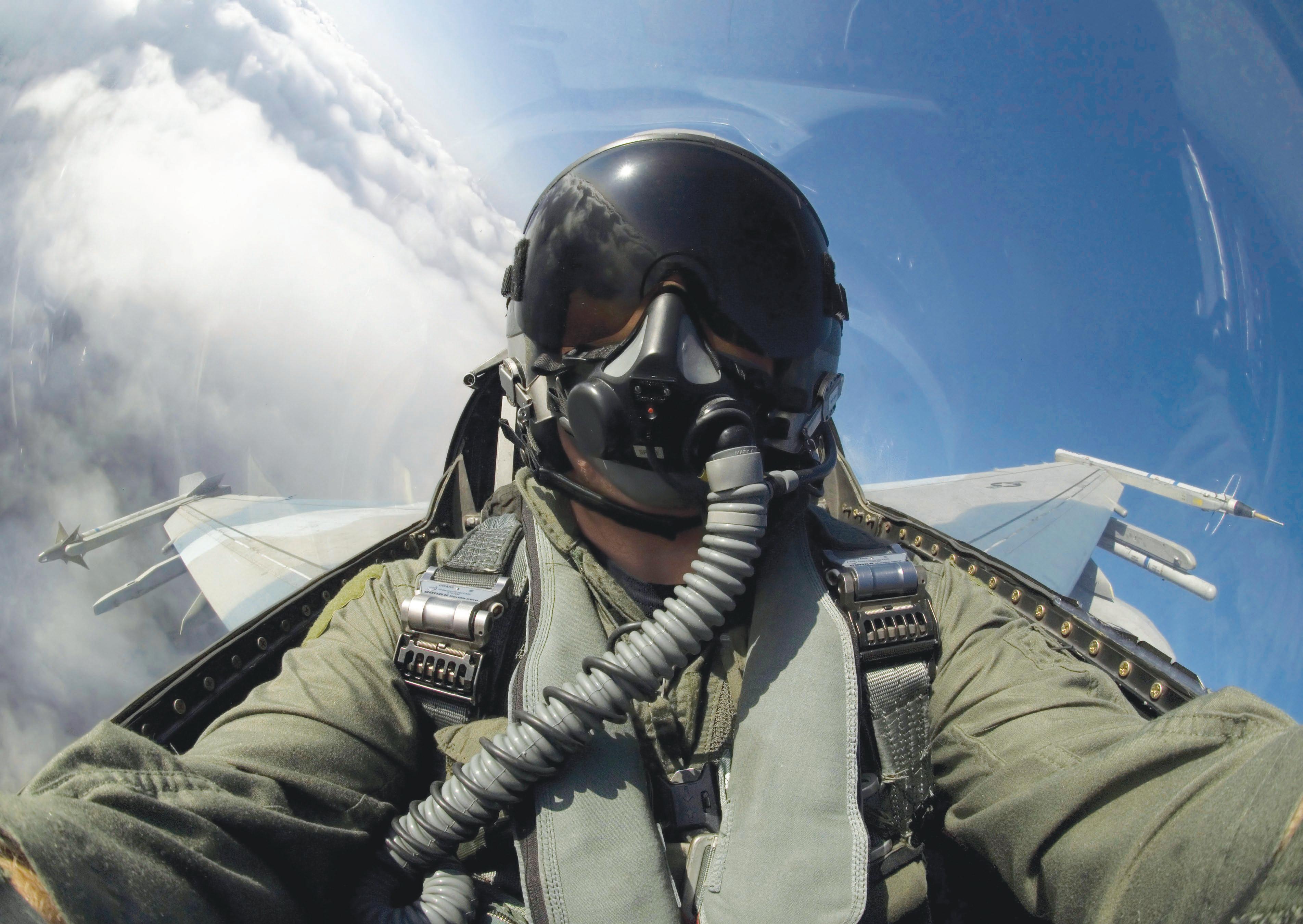
RF-over-Fiber
Network
RF-over-Fiber in Action
Harnessing the Micro Electronics Revolution
Published by Global Business Media
Solutions for Military Applications
Centric Warfare plus Communication at the Speed of Light
Global Defence Market Overview
TECHNICAL STUDY
IMPROVING SECURITY OF COMMUNICATION LINKS IN CRITICAL MILITARY MISSIONS AND RF-OVE-FIBER TECHNOLOGY
Published by Global Business Media
Global Business Media Limited
62 The Street Ashtead Surrey KT21 1AT United Kingdom
Switchboard: +44 (0)1737 850 939
Fax: +44 (0)1737 851 952
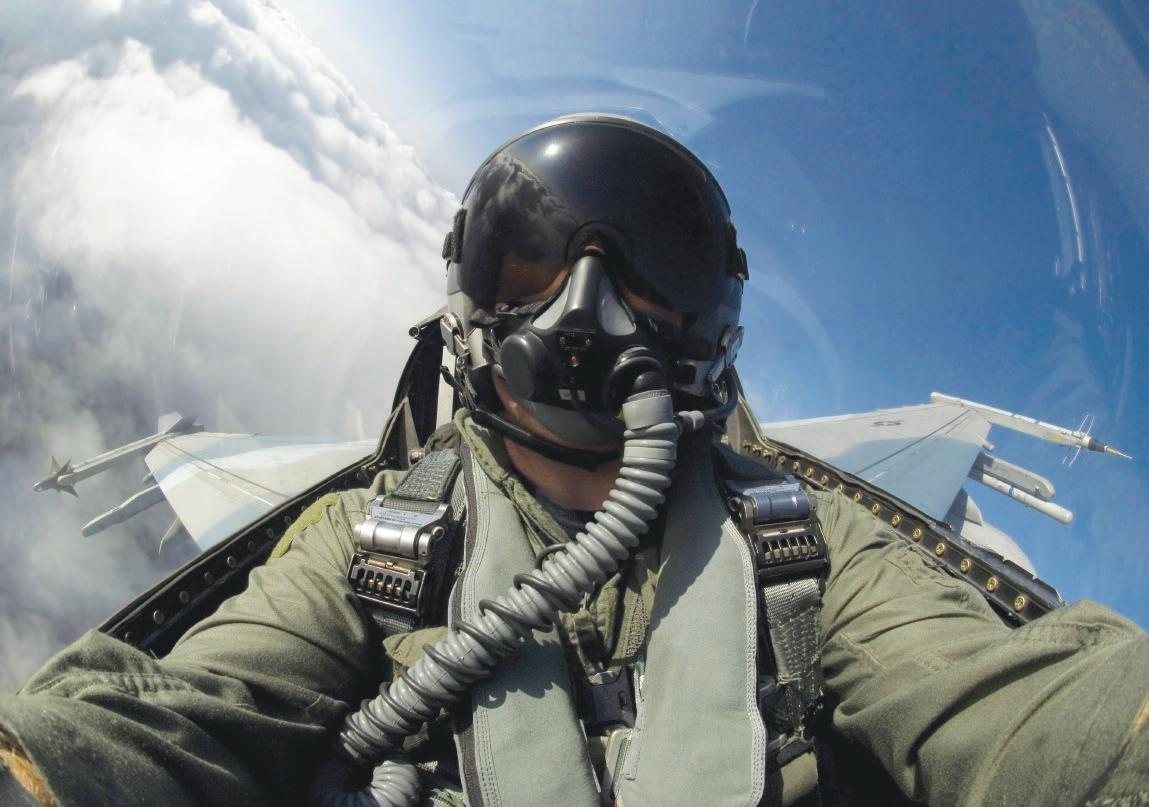
Email: info@globalbusinessmedia.org
Website: www.globalbusinessmedia.org
Publisher
Global Business Media
Senior Analyst
Martin Richards
Editor
John Hancock
Project Manager
Paul Davies
For further information visit: www.globalbusinessmedia.org
3 Chad
What
Why
What
Why
What
The opinions and views expressed in the editorial content in this publication are those of the authors alone and do not necessarily represent the views of any organisation with which they may be associated.
The views and opinions expressed in this publication do not necessarily express the views of the Publishers or the Editor.
While every care has been taken in the preparation of this publication, neither the Publishers nor the Editor are responsible for such opinions and views or for any inaccuracies in the articles.
© 2023. The entire contents of this publication are protected by copyright. Full details are available from the Publishers. All rights reserved. No part of this publication may be reproduced, stored in a retrieval system or transmitted in any form or by any means, electronic, mechanical photocopying, recording or otherwise, without the prior permission of the copyright owner.
IMPROVING SECURITY OF COMMUNICATION LINKS IN CRITICAL MILITARY MISSIONS WITH RF-OVER-FIBER TECHNOLOGY
Contents Introduction 2 Mary Dub, Editor RF-over-Fiber Solutions for Military Applications
Trevithick,
Program Manager: RF Systems Business Abstract Introduction
HUBER+SUHNER,
Is RF-over-Fiber?
RF-over-Fiber?
Overview)
(Technical
RF-over-Fiber
Huber+Suhner Offer?
Products Does
Should Customers Choose HUBER+SUHNER?
are the Benefits of
RF-over-Fiber in Defence Applications? Which Defence Applications Can Benefit From Using RF-over-Fiber? Network Centric Warfare plus Communication at the Speed of Light 9 Mary Dub, Editor The Predicted Spectrum of Applications for Fiber Optic Cables RF-over-Fiber Meeting the Demand for Mobile Data Access Where the Commercial Market Leads the Military Follow Global Defence Market Overview 11 Patric Keller, HUBER+SUHNER, Market Manager: Aerospace+Defence Regional Defence Spending Trends Global Growth Areas – Applications and Technologies Future Trends – HUBER+SUHNER Technologies and Capabilities Summary of the Global Defence Spending Outlook RF-over-Fiber in Action 13 Don McBarnet, Defence Technology Writer RF-over-Fiber Valued in Naval and Land Applications RF-over-Fiber Offers Commercial Aircraft Enhanced Safety QinetiQ’s Tarsier System and Other FOD Prevention Systems Harnessing the Micro Electronics Revolution 15 Mary Dub, Editor The Exponential Growth in Network Mobile Data Demand DARPA’s Vision of the Achievable Future in Recent Budget Requests to the President DARPA’s Hollow Air filled Core: Light through Air References 17 WWW.GLOBALBUSINESSMEDIA.ORG | 1 Improving Security of Communication Links in Critical Military Missions with RF-over-Fiber Technology Published by Global Business Media RF-over-Fiber Solutions for Military Applications Network Centric Warfare plus Communication at the Speed of Light Global Defence Market Overview RF-over-Fiber in Action Harnessing the Micro Electronics Revolution TECHNICAL STUDY
Using
Introduction
REAL TIME communication at the speed of light, to deliver streamed data on a mobile computer/smartphone is now an almost universal consumer aspiration. Can it be delivered to the millions, no, billions of new mobile devices being used in the world today? The answer to that question is, yes – thanks to the steps forward taken in RF-over-Fiber systems. Data streaming can be established in hard to reach areas, within buildings such as airports, shopping malls and distant airport runways. These RF-over-Fiber systems are the topic of this Special Report, particularly in relation to military applications.
The opening article examines the importance of finding ways to increase the distance between communications equipment and military personnel, to ensure their safety. It goes on to describe RF-overFiber, which enables communication links between distances of 100km and more while reducing the amount of cable within the systems – thus supporting rapid deployment. HUBER+SUHNER is one of the only companies in the world with expertise and experience in Radio Frequency, Fiber Optics and the technology to combine them for use in a single solution.
The second piece seeks to untangle the threads of RF-over-Fiber technology and systems and looks at their application in 2016 in the consumer and the military market. Cable links depend on high quality cable, but also on the engineering of the connections, which can literally make or break a system.
The third article looks at global defence spending trends in the last two years and the expected growth up until 2025 during which time, some experts predict, defence spending in the Asia-Pacific region will surpass North America by 2020.
It would be a mistake to simplify the many and various applications of RF-over-Fiber in use in the US military and in commercial applications. The lightness and resilience of fiber optic cables make them ideal for aerospace, army and naval applications. They also have a role in ensuring the security of commercial airports from foreign object debris on the runway. This is an area which commands attention after a US FAA (Federal Aviation Authority) advisory circular stipulating that FOD prevention systems should be installed in order to improve passenger security.
And, of course, the future is the final topic. The future is now for the mobile-streamed data market, as consumer demand continues its exponential growth, the market will need to find ways to meet the requirements. The US DARPA (Defense Advanced Research Projects Agency) research teams are committed to a medium and long-term future that includes contemporary and future systems of photonics and optoelectronics. The future of RF-overFiber seems secure.
Mary Dub Editor
IMPROVING SECURITY OF COMMUNICATION LINKS IN CRITICAL MILITARY MISSIONS WITH RF-OVER-FIBER TECHNOLOGY 2 | WWW.DEFENCEINDUSTRYREPORTS.COM
Mary Dub has written about international security in the United States, Europe, Africa and the Middle East as a television broadcaster and journalist and has a Masters degree in War Studies from King’s College, London.
RF-over-Fiber Solutions for Military Applications
Chad Trevithick, HUBER+SUHNER, Program Manager: RF Systems Business
Abstract
Safety of military personnel and improving the security of communication links are critical objectives in military missions.
In order to ensure the safety of military personnel, it is important to find ways of increasing the distance between personnel and the communications equipment; and to provide solutions that support rapid deployment.
Increasing the security of communication links requires technology that is difficult to intercept and that is immune to various forms of interference.
RF-over-Fiber is the ideal solution for applications that seek to increase safety, improve security and enhance overall system performance.
By enabling distances of 100km and more between communication links and by reducing the amount of cable within the systems, which supports rapid deployment, the use of RF-overFiber contributes significantly to the increase in military personnel safety.
The security of communication links are vastly improved by the use of Fiber Optics, which transmits data over light, making it very difficult to intercept. The use of Fiber Optics also provides immunity to interferences caused by radio signals, electro-magnetic influences and lightning.
HUBER+SUHNER is one of the only companies in the world with expertise and experience in Radio Frequency, Fiber Optics and the technology to combine them for use in a single solution.
Introduction
The market is evolving at a significant pace. With customers requiring that new systems combine various technologies, HUBER+SUHNER has positioned itself to be able to provide customers with end-to-end hybrid solutions.
The RF-over-Fiber Series enables the use of Radio Frequency and Fiber Optics in a single system. With these two technologies forming a part of HUBER+SUHNER’s core technology offering, HUBER+SUHNER is using its vast experience and expertise to deliver best-inclass technology conversion modules.
What Is RF-over-Fiber?
RF-over-Fiber is a technology that describes the conversion of a Radio Frequency (RF) signal into a Fiber Optic (FO) signal and then back to an RF signal. The first level of conversion (from RF to FO) is performed using an LED or laser diode. Once converted, the optical signal is transmitted over an FO cable. The second level of conversion (from FO back to RF) is performed using a photodiode. A basic RF-over-Fiber data link consists of an RF source, an RF-over-Fiber transmitter, an FO cable, an RF-over-Fiber receiver and an RF receiver system (figure 1).

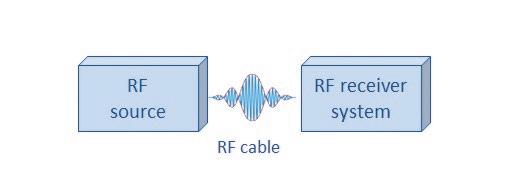
The maximum distance covered by a basic single mode RF-over-Fiber link (below) is around 100km.
The RF-over-Fiber data link enables the transmission of data over significantly longer distances than traditional RF systems (figures 2.1 and 2.2). This is due to FO’s inherent low-loss characteristics. The introduction of FO also ensures that the system is immune to electro-magnetic interference (EMI) and electro-magnetic pulse (EMP), which has a positive impact on the performance of the system.

The maximum distance covered by a basic high bandwidth RF link (below) is around 100m.
The maximum distance covered by an amplified RF link in the example below is around 300m. The use of RF-over-Fiber data links for the transmission of RF (analog) signals
IMPROVING SECURITY OF COMMUNICATION LINKS IN CRITICAL MILITARY MISSIONS WITH RF-OVER-FIBER TECHNOLOGY WWW.GLOBALBUSINESSMEDIA.ORG | 3
FIGURE 1: BASIC SINGLE MODE RF-OVER-FIBER DATA LINK
FIGURE 2.1: BASIC RF LINK
FIGURE 2.2: AMPLIFIED RF LINK
By enabling distances of 100km and more between communication links and by reducing the amount of cable within the systems, which supports rapid deployment, the use of RF-over-Fiber contributes significantly to the increase in military personnel safety
has expanded significantly in the last two decades. Initially used to distribute cable television (CATV) signals, RF-over-Fiber has grown significantly in both commercial as well as defence applications.
Why RF-over-Fiber?
(Technical Overview)
The main advantages that RF-over-Fiber systems have over traditional RF system are that they:
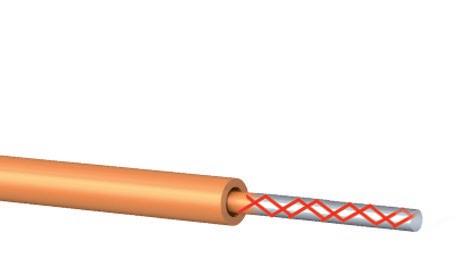
• allow for greater distances between the RF source and the RF receiver system
• are immune to EMI & RFI
• are immune to EMP
• are more difficult to intercept (“tap”)
• are lighter in weight
These advantages are made possible by the replacement of RF signals by light (FO) signals. The low-loss (attenuation) characteristics within FO, which allow for greater distances to be achieved, are based on the mode of signal propagation and the wavelengths that are used for data transmission.
FO makes use of two modes of signal propagation, namely multimode and single mode.
A key difference between an RF-over-Fiber system and a traditional RF system is the use of active components in RF-over-Fiber systems compared with passive components in traditional RF systems.
The active components have a direct impact on parameters that affect the performance of a system. Some of the most important characteristics of an RF-over-Fiber system are:

• Noise figure: This is one of the major considerations when designing an RF-overFiber link. The noise figure generally refers to the sum of all noise within a system. Noise is expressed in dB/Hz. There are three sources of noise, namely Thermal noise, Shot noise and Laser noise.
o Thermal noise is unavoidable and refers to random charge carriers inside a conductor;
o Laser noise refers to random changes in signal intensity;
o Shot noise refers to random changes of photons arriving at the photodiode.
Multimode:
Multimode fibers have a bigger core than single mode fibers, which allows for multiple light transmissions to pass through the core simultaneously. Whilst this enables more data to pass through the fiber at any given time, the signal dispersion of the light source (typically LED) results in greater signal loss. This means that multimode fibers are generally used in applications that require data to be transmitted over short distances.
• Harmonics: Distortions and deviations (in current and voltage) from sinusoidal waveforms are referred to as harmonics. A pure sinusoidal voltage is a conceptual quantity produced by an ideal AC generator. Deviations from a pure sine wave creates a deviation in the form of a periodic function. By definition, the voltage distortion contains harmonics.
• Spurious-free dynamic range (SFDR): Is the range between the smallest discernable signal in a system and the largest signal that can be introduced without creating detectable noise. SFDR is very important in distinguishing the signal from other noise and spurious frequencies.
• Third Order Intercept Point: The third-order intercept point is an extrapolated convergence (not directly measurable) of intermodulation distortion products at a desired output. It indicates how well a device or system performs in the presence of strong signals.
• P1dB: Is used to define the upper limit of the dynamic range of an amplifier.
Single mode:
Single mode fibers have a small core that allows only one light source (typically lasers) to be transmitted. The reduction in signal dispersion and the resulting reduction in signal losses enable the signal to travel further.
What RF-over-Fiber Products Does Huber+Suhner Offer?
HUBER+SUHNER is focusing on three areas of conversion, namely RF-over-Fiber, GPS-overFiber and LAN-over-Fiber.
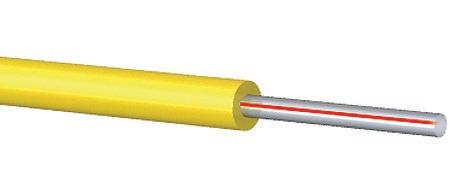
IMPROVING SECURITY OF COMMUNICATION LINKS IN CRITICAL MILITARY MISSIONS WITH RF-OVER-FIBER TECHNOLOGY 4 | WWW.GLOBALBUSINESSMEDIA.ORG
The use of RF-over-Fiber contributes significantly to the increase in military personnel safety by enabling greater link distances and by supporting rapid deployment by using less and lighter cable
OVERVIEW OF PROPAGATION MODE AND SIGNAL LOSS PER WAVELENGTH (INCLUDING RF COMPARISON)
RF-over-Fiber (RFoF):
Driven by a philosophy of providing high density RF connectivity, whilst significantly reducing cable footprints; HUBER+SUHNER’s single mode, simplex and duplex systems are both flexible and perfect for harsh environments. Flexibility is achieved by providing customers with a wide range of options when it comes to inter-connectivity, whilst the scalability of the systems enable an unlimited RF connectivity density. The use of HUBER+SUHNER’s renowned components, such as RADOX and Q-ODC-12, ensures that the system is able to be deployed in any environment and with a significantly smaller cable footprint.
The standard RFoF modules are available in 1, 6 and 12 ports and cover a wide frequency range of 1 MHz to 20 GHz. The systems are capable of covering distances of more than 100km and are perfect for applications requiring secure, low loss, light-weight and high-density connectivity.
GPS-over-Fiber (GPSoF):
LAN-over-Fiber (LANoF):
With the use of multimedia continuing to increase within the operations landscape (from planning to de-briefing), our modules are focused on providing Gigabit connectivity within challenging environments.
Again, the use of HUBER+SUHNER’s RADOX and Q-ODC-12 components ensure that the exposed portions of the system remain functional within harsh environments, whilst the interconnect within a mobile structure (shelter or vehicle) remains robust and functional within environments exposed to, for example, intense vibration.
The standard LANoF modules are available in 1, 6 and 12 ports and can be easily integrated into existing network infrastructures.
The LANoF system is particularly well suited to applications that require “field LAN” capabilities for data synchronisation, diagnostics, remote identification and software distribution.
Why Should Customers Choose HUBER+SUHNER?
Our GPSoF modules are focused on distributing a single GPS signal into multiple receiver systems. This approach ensures that signal data, such as time synchronisation into separate, yet connected, systems is always the same.
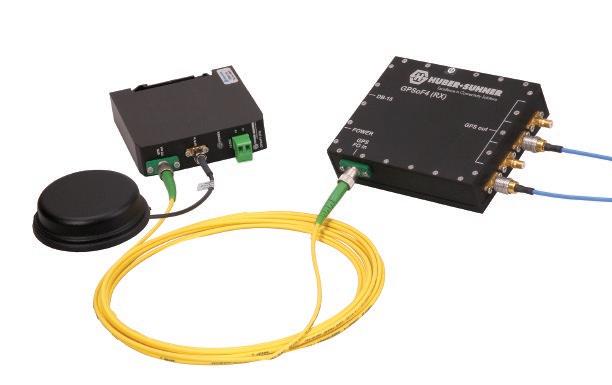
Standard GPSoF systems include both single and multiport solutions; and accommodate both L1 and L2 bands.
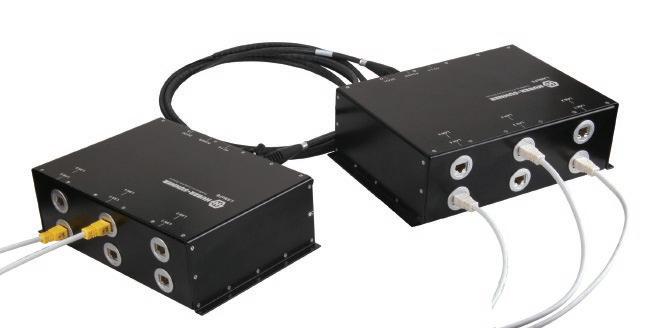
In addition to the GPSoF modules, HUBER+SUHNER also provides a Time & Frequency Standard (TFS) Module. This module uses 1PPS to ensure that time synchronisation is still possible in the event of a loss of the GPS signal. The pulse is synchronised to the average of the GPS signal. The module also provides a 10 MHz electrical output, which is used for reference signalling.
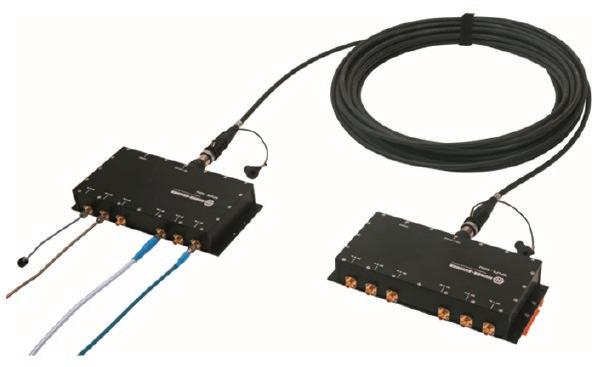
The small form factor of the GPSoF modules ensures that the systems are ideal for both fixed and mobile applications; where space may be limited.
HUBER+SUHNER is uniquely positioned in the RF-over-Fiber market; as one of a very few organisations with experience and expertise in both the RF-over-Fiber conversion technology as well as RF and FO interconnectivity. This means that HUBER+SUHNER is able to provide fast, flexible and customised solutions that meet customers’ specific RF-overFiber needs. Whether it be the fine-tuning of opto-electronic parameters; or providing interconnect expertise and products to support application-specific requirements, HUBER+SUHNER is able to offer the most effective end-to-end interconnect solutions.
Types of solution providers:
• Interconnect providers – experts in RF & FO interconnect, but not in the conversion technology.
• Conversion module providers – experts in conversion technology, but not in RF & FO interconnect.
• Systems Integrators – experts in solution scoping and sourcing. No core interconnect expertise.
• End-to-end solution providers – experts in all aspects of an RF-over-Fiber solution.
IMPROVING SECURITY OF COMMUNICATION LINKS IN CRITICAL MILITARY MISSIONS WITH RF-OVER-FIBER TECHNOLOGY WWW.GLOBALBUSINESSMEDIA.ORG | 5
The use of FO cables, within a traditional RF system makes it possible to position the shelters far away from the antennas, whilst ensuring that the links between the antennas and the shelter remain secure
What are the Benefits of Using RF-over-Fiber in Defence Applications?
The benefits of combining both RF and FO in a single solution are the following:
• no changes are required to existing infrastructures;
• systems are more secure – no EMI & RFI, no interception;
• better performance – systems have less loss, and are immune to EMP;
• systems require less cabling and are lighter in weight;
• installation, maintenance and troubleshooting are simplified.
Which Defence Applications Can Benefit From Using RF-over-Fiber?
Application overview:
Shelters (RFoF, GPSoF, LANoF)
Key Benefits:
• Safety – Enables greater distances between the shelter personnel and the RF equipment.
• Security – immune to EMI & RFI. Lower risk of interception.
• Better performance – greater distances covered with very low loss.
• Mobility – light-weighting and reduction of cable footprint enable rapid deployment.
Shelter connectivity illustrates perfectly the benefits of an RF-over-Fiber system. Highly mobile and deployed in harsh environments, connectivity as well as the safety of the control centre are key elements of RF-over-Fiber within an antenna remoting system.
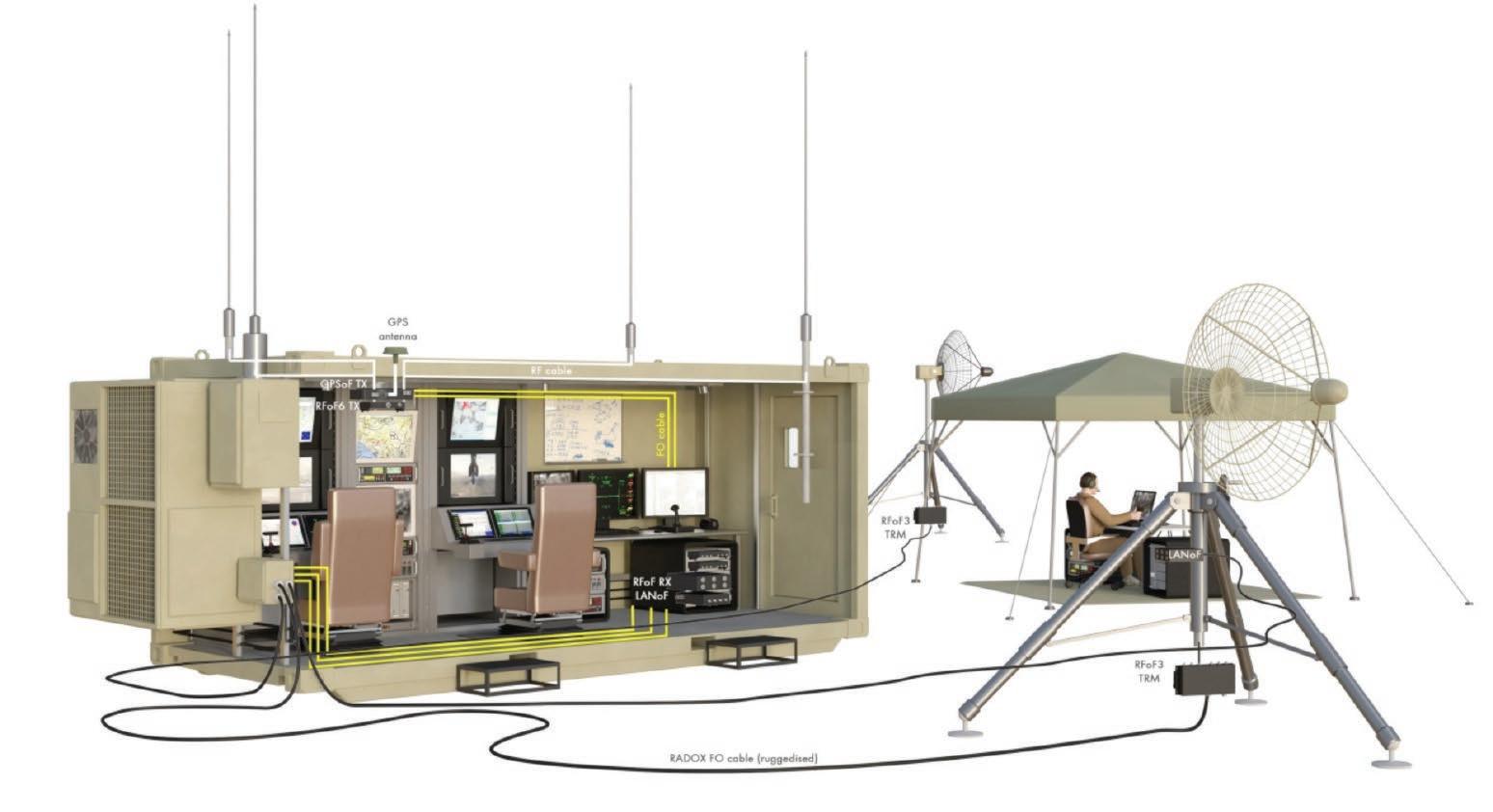
The use of FO cables, within a traditional RF system, makes it possible to position the shelters far away from the antennas, whilst ensuring that the links between the antennas and the shelter remain secure.
The use of FO cables also supports the mobility of the application by reducing the cable footprint as well as light-weighting the solution. This dramatically simplifies and speeds up the installation and maintenance of the system. The use of HUBER+SUHNER’s RADOX ® technology ensures superior performance in harsh environments. Immunity to EMI, EMP and RFI provide the important finishing touches to this high performing and secure system solution. In addition to the RF-over-Fiber solution, HUBER+SUHNER covers all additional connectivity requirements within a shelter. Our antennas, lightning protectors and military qualified cable assemblies are

IMPROVING SECURITY OF COMMUNICATION LINKS IN CRITICAL MILITARY MISSIONS WITH RF-OVER-FIBER TECHNOLOGY 6 | WWW.GLOBALBUSINESSMEDIA.ORG
HUBER+SUHNER is able to provide fast, flexible and customised solutions that meet customers’ specific RF-over-Fiber needs
Application overview: Vehicles (GPSoF, LANoF)
Key Benefits:
• Mobility – reduction of cable footprint enables rapid deployment.
Application overview: SATCOM (RFoF, LANoF)
Key Benefits:
• Security – immune to EMI & RFI. Lower risk of interception.
• Better performance – greater distances covered, immune to EMP and very low loss.
• Mobility – Less cable and weight supports rapid deployment in mobile applications.
• Efficient – Faster and simplified installation and maintenance (key in mobile applications –SNG & VSAT).
• Form Factor – small modules and cables ensure easy integration.
• Better performance – “Field LAN” is a game changer. GPS signal distribution is smarter.
• Security – immune to EMI /RFI. Lower risk of interception.
• Ruggedised – designed for use in harsh environments.
RF-over-Fiber is creating new opportunities for cabled solutions within vehicle applications. Highly mobile and exposed to challenging environments, the RF-over-Fiber Series is paving the way for the next generation of end-to-end connectivity solutions in this application landscape.
GPS-over-Fiber enables a single GPS signal to be distributed into multiple receiver systems. The small form factor adds significant value within the vehicle with both the conversion modules and FO cable designed to use as little space as possible, whilst eliminating all forms of (EM & RF) interference.
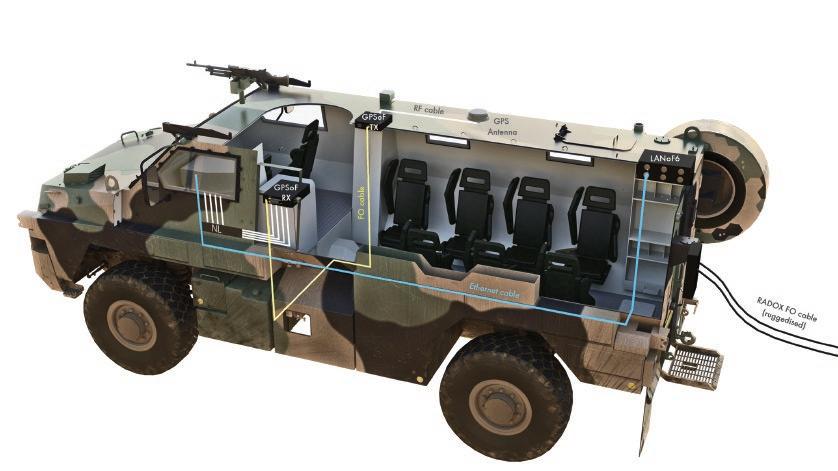
LAN-over-Fiber facilitates vehicle identification as well as data and software syncronisation for vehicles that are deployed in the field. This new “field LAN” capability, based on a ruggedised gigabit FO network is changing the way that media and data are being shared in operations.
In SATCOM applications, RF-over-Fiber enables communication between satellites and control centres. The communication link is created by connecting the antenna to the control centre. RF-over-Fiber supports both fixed earth installations and mobile applications.
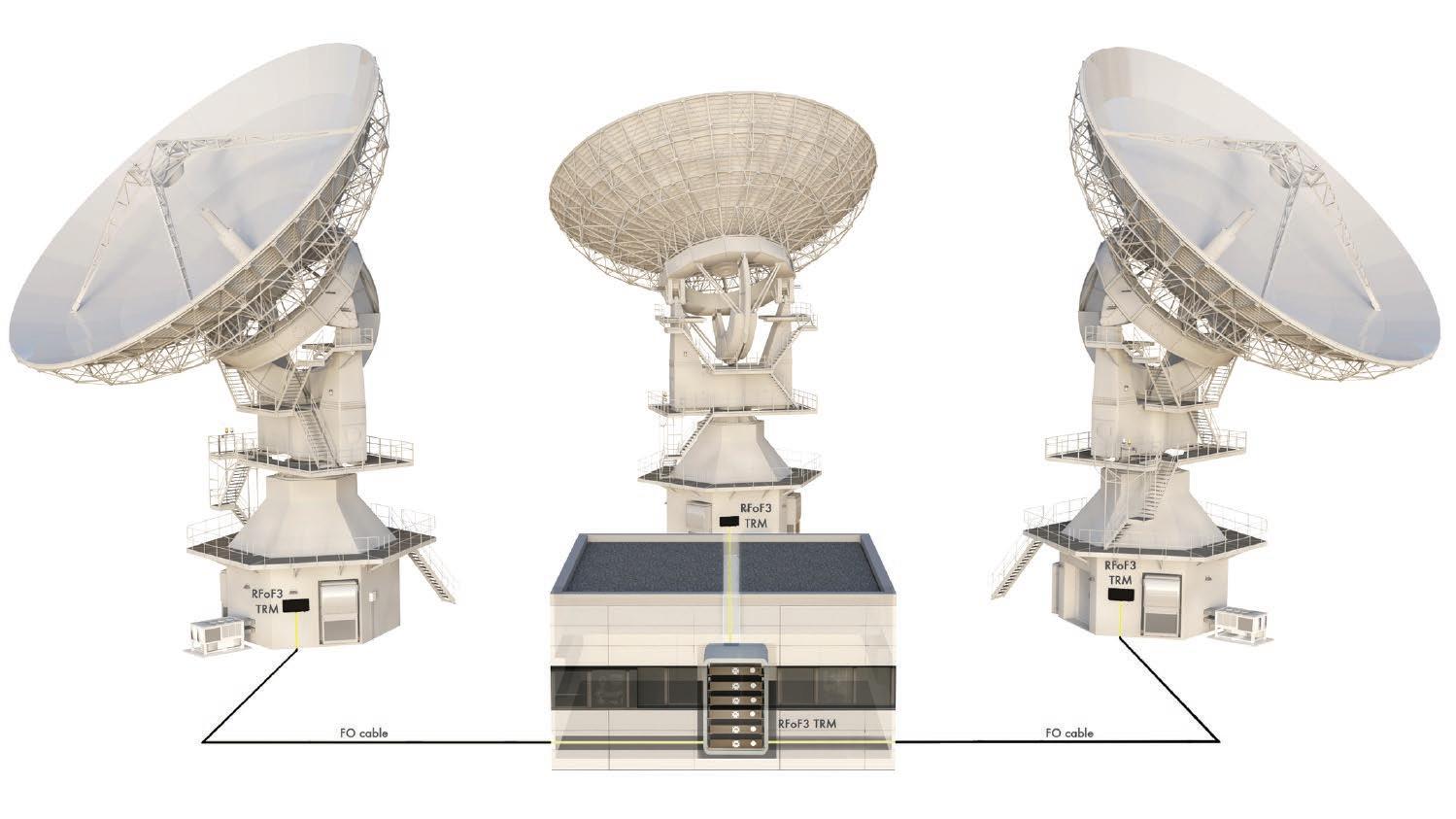
Broad frequency ranges, excellent performance and security are critical aspects that are perfectly addressed by HUBER+SUHNER’s RF-over-Fiber products. With single modules that cover all intermediate frequency (IF) signals as well as the L, S and C bands, HUBER+SUHNER not only meets the frequency range requirements in SATCOM, but also has Low Noise modules in its portfolio that can be used in applications that are especially sensitive to noise. The Low Noise modules halve the noise figure from 15 dB to 7 dB (IF signals).
Excellent performance and the security of the SATCOM links are further supported by immunity to EMI, RFI and EMP.
The use of LAN-over-Fiber is growing within the SATCOM applications landscape. Ethernet connectivity for VOIP, VPN connectivity and other data network services are easily integrated into both fixed and mobile infrastructures. Gigabit LAN modules ensure the future-proofing of all SATCOM applications.
IMPROVING SECURITY OF COMMUNICATION LINKS IN CRITICAL MILITARY MISSIONS WITH RF-OVER-FIBER TECHNOLOGY WWW.GLOBALBUSINESSMEDIA.ORG | 7
“A city on the sea”, naval applications have both a requirement for intravessel communication and networking systems, as well as missionrelevant systems
Application overview: Aircraft (RFoF)
Application overview:
Naval Vessels (RFoF, GPSoF, LANoF)
Key Benefits:
• Scalability – perfect for applications requiring a high density of RF connectivity.
• Better performance – significantly less loss.
• Efficient – less cable means faster and easier installation and maintenance.
• Light-weighting – saves costs or allows for weight re-distribution.
• Security – immune to EMI & RFI.
• Ruggedised – designed for use in airborne conditions.
The integration of RF-over-Fiber solutions within airframe applications is growing rapidly. High density RF connectivity and light-weighting are key elements that are optimally addressed by RF-over-Fiber. Often requiring upwards of 50 RF connections between various sensors, antennas and systems, the HUBER+SUHNER RF-overFiber products provide flexibility by ensuring that the solution is easily scalable.
For example, the use of five 12 Port modules easily covers the requirement of 50 RF connections; whilst even providing reserve capacity for future connectivity increases. The use of five modules means that only five cables are required to cover the entire connectivity demand. This not only significantly decreases the overall cable footprint, but allows for meaningful weight reduction within the aircraft.

The light-weighting of the connectivity solution, whilst retaining optimal performance, allows for the weight to be used somewhere else in the aircraft; or for the total weight of the aircraft to be reduced. The reduction of the weight of the aircraft offers better fuel efficiency, which either save costs or provides the capability to extend the time and range of a mission.
Key Benefits:
• Scalability – perfect for applications requiring a high density of RF connectivity.
• Utility – covers both internal and missionrelevant systems.
• Efficient – less cable means faster and easier installation and maintenance.
• Security – immune to EMI & RFI.
• Ruggedised – designed for use in harsh environments.
“A city on the sea”, naval applications have both a requirement for intra-vessel communication and networking systems; as well as missionrelevant systems.
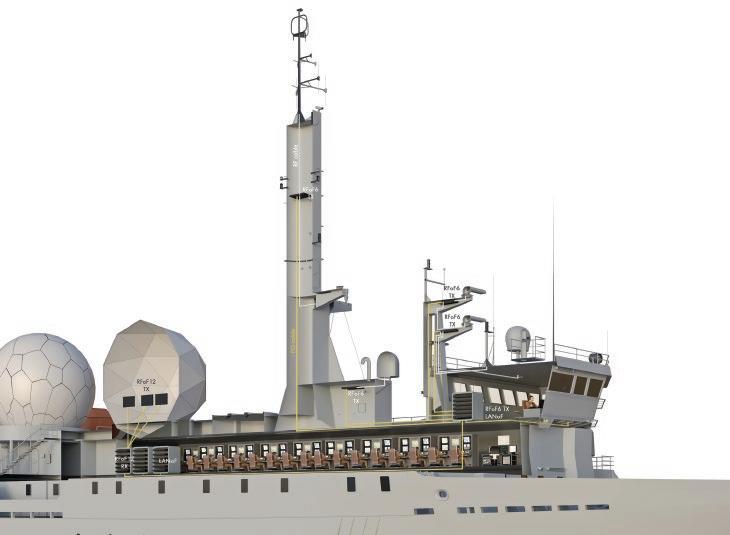
The density of connectivity as well as the distances between the RF equipment and the receiver systems, make the RF-over-Fiber Series ideal for naval applications.
The easily scalable RF-over-Fiber products ensure that the RF density requirements are met, whilst at the same time, reducing the overall cable footprint on the vessel. The broad frequency range also ensures that the RF-over-Fiber modules can be used for navigation, inmarsat, COMINT, ELINT and other antenna systems. The use of LAN-over-Fiber provides a ruggedized Gigabit FO network on the vessel.
IMPROVING SECURITY OF COMMUNICATION LINKS IN CRITICAL MILITARY MISSIONS WITH RF-OVER-FIBER TECHNOLOGY 8 | WWW.GLOBALBUSINESSMEDIA.ORG
With the use of multimedia continuing to increase within the operations landscape (from planning to de-briefing), our modules are focused on providing Gigabit connectivity within challenging environments
Network Centric Warfare plus Communication at the Speed of Light
Mary Dub, Editor
NETWORK CENTRIC Warfare envisaged networked communication in real time. This was first outlined by John Gartska in 1999, when he was Assistant Director, Concepts and Operations at the US Office of Force Transformation. But real time communication was an aspiration rather than a reality. The revolution in photonics and the increasingly ubiquitous use of fiber optic cable, rather than coaxial cable, takes the revolution in network centric warfare one step forward. How? The first stages of the fiber optic revolution in communication occurred in the 1950s. However, the high value of fiber optic cables for military applications were noted in a RAND report in 1989.1 The RAND report stated that a technological revolution in information transmission had occurred within the last two decades. Fiber optics, hair thin glass fibers carrying laser light, had for many become the preferred mode for commercial long distance telecommunications. This revolution, enabled by the solid-state laser and the production of optical fibers with low loss, expanded into other related areas such as sensors and computing. The researchers at RAND highlighted the military value of this revolution. Optical fiber cables in information systems have qualities that make them particularly useful for military as well as commercial applications. These attributes include immunity to electro-magnetic interference, relative security from eavesdropping and the ability to span long distances without repeaters as well aslow cable weight. However, military applications impose additional requirements on fiber optic systems, which have limited their viability. These requirements include wider operation and storage temperatures and the ability to withstand severe vibration, shock and other mechanical stresses. This was published 26 years ago and many of the issues they address have been resolved. In fact, much of the RAND researchers’ vision of the future has become a reality in 2016.
The Predicted Spectrum of Applications for Fiber Optic Cables
The critical advantage of fiber optic cables is the wide range of applications they can be used in. According to the RAND report, fiber optics can offer the military substantial benefit in weapon systems, sensor and surveillance systems, optical computing systems as well as information transmission aboard vehicles.2 Envisioned weapon systems include fiber optic guided missiles (FOG-M) for the navy and army. The inherent advantages of fiber optics make them especially wellsuited for use aboard military and commercial vehicles. Ground, sea and air vehicles can all benefit from the application of this technology. With the continued emphasis in aircraft design, lighter vehicles and the use of composites, for fuel savings and radar absorption, fiber optics provide an avenue of great promise. The fibers are much lighter than copper cable and are essentially immune to electromagnetic interference.
RF-over-Fiber
The first two paragraphs of this article have given an historic view of the potential achievement of fiber optic cables. The central focus of this Report is to look at how fiber optic cable use has advanced even further with the development of radio frequency distribution over fiber optic cables. In the introduction to an article in the Journal of Lightwave Technology, researchers at Cambridge University (UK), point out the exponential growth in demand for data from today’s usage of mobile data devices3. They quote the current number of wireless devices as at an all-time high with an estimated 6.8 billion mobile subscriptions and 1.5 billion WLAN (Wireless Local Area Network) capable devices worldwide. This has driven a huge increase in usage of wireless data, the demand for which
IMPROVING SECURITY OF COMMUNICATION LINKS IN CRITICAL MILITARY MISSIONS WITH RF-OVER-FIBER TECHNOLOGY WWW.GLOBALBUSINESSMEDIA.ORG | 9
With the continued emphasis in aircraft design on lighter vehicles and the use of composites for fuel savings and radar absorption, fiber optics provide an avenue of great promise
is to increase 13 fold from 2012 to 20174. As a result, it is forecast that in the next few years the capacity load on wireless networks will outstrip supply by as much as 90%. This is of particular importance in indoor environments, where an estimated 80% - 90% of wireless data traffic originates. It is here that RF-over-Fiber can make a meaningful contribution towards improving supply.
Meeting the Demand for Mobile Data Access

DAS (Distributed Antenna Systems) such as the one discussed in the Journal of Lightwave Technology article, offer a system where antennae fed from multiple collocated wireless base stations are transported to remotely located antennas. DAS systems have been used for some time to provide In-Building Coverage (IBC).To date, there have been more than 89,000 installations worldwide.5 Similar to LAN-over-Fiber and GPS-overFiber, they offer the commercial advantage of Wi-Fi availability and data access, where broadband is not available or has been denied. The use of mobile data from commercially available smartphones has developed faster than many parallel military systems and in many countries Commercial Off-The-Shelf (COTS) products are bought and used by the military.
Where the Commercial Market Leads the Military Follow
In the past, it has been easy to draw a line between commercial and military products. This is, however, becoming an increasingly grey area as the pace of development of the consumerled commercial world has resulted in the military following and using COTS products. The speed of adoption and costs have been the main drivers of this trend. Now, where the commercial world leads in establishing indoor DAS systems – in a Brazilian shopping centre or a new Asian airport complex – the military will follow. Why? Because in an uncertain world, modern and future hybrid warfare may well take place in a broadband denied or inaccessible world.6 DARPA expects that the growth in sensor systems, unmanned systems, and internetworked weapons systems will strain the size of networks that our current communications technology can support in the contested environment. As adversary capabilities advance, frequently using commercially available systems, the US Department of Defense needs new techniques to quickly and efficiently accommodate better networking and improved communications capabilities – specifically communications systems with higher capacity, lower latency, greater jamming resistance and reduced detectability. This will mean that, in the future, the Department of Defense will look to commercial communication architectures.7
IMPROVING SECURITY OF COMMUNICATION LINKS IN CRITICAL MILITARY MISSIONS WITH RF-OVER-FIBER TECHNOLOGY 10 | WWW.GLOBALBUSINESSMEDIA.ORG
Fiber optics can offer the military substantial benefit in weapon systems, sensor and surveillance systems, optical computing systems and information transmission aboard vehicles
Global Defence Market Overview
Patric Keller, HUBER+SUHNER, Market Manager: Aerospace+Defence
GLOBAL DEFENCE spending experienced an increase in 2014 after two years of stagnation in 2012 and 2013. This increase is considered to be a result of changes in the geopolitical landscape, which has involved both state and non-state players.
Based on the current global environment, global defence spending is expected to grow at a Consolidated Annual Growth Rate (CAGR) of 4% in 2025 – to around US $2.5 trillion from the current level of US $1.7 trillion. Defence procurement budgets are expected to account for approximately one-third of the total defence spending, which is expected to reach US $800 billion during this period.
Regional Defence Spending Trends
Experts predict that defence spending in the Asia-Pacific region, and especially East Asia, will increase significantly in the next few years; with some suggesting that defence spending in the Asia-Pacific will surpass North America by 2020.
Budget constraints in North America; and Europe’s focus on stabilising defence budgets are expected to keep the overall defence spending in these regions at current levels.
In the Asia-Pacific, it is expected that border and maritime disputes, linked to geopolitical activities, will continue to drive increases in defence spending. Economic growth in the region further supports this defence spending trend.
The Maintenance, Repairs & Overhauling (MRO) sector is also expected to experience rapid growth due to the implementation of a number of new technology platforms by countries such as India, Saudi Arabia as well as other EAGLE & Nest economies. Here, the cost of operating these more complex platforms is expected to increase budgets by around 7% (compared to 4% growth in procurement).
Global Growth Areas –Applications and Technologies
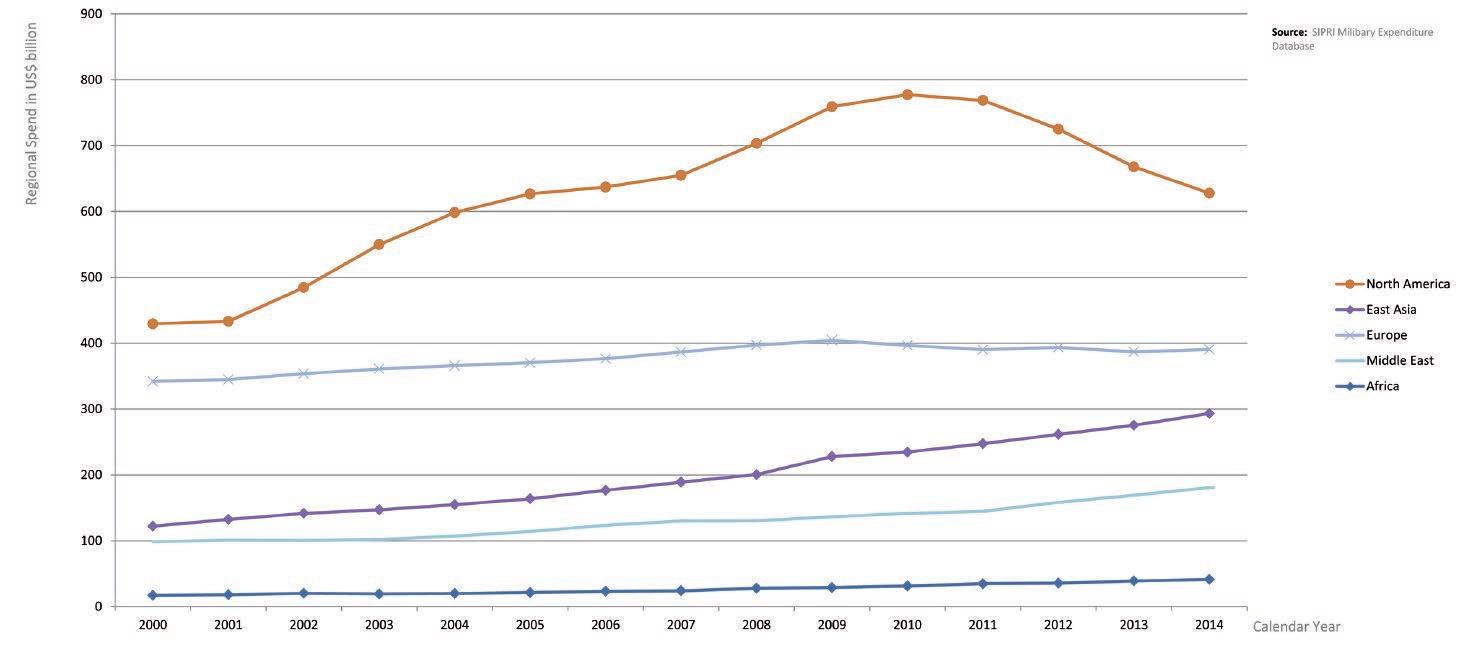
C4I (Command, Control, Communications, Computers & Intelligence) and ECM (Electronic Counter-Measure) applications are expected to be key growth areas over the next 10 years. Here, land-based C4I, airborne C4I & signal jamming will most likely see a significant increase in investment intensity.
Enhanced communication systems that deliver improved system performance, high density connectivity, improved security and mobility (light-weighting & small form factor) are gearing up to be key drivers of spending in vehicle, shelter and aircraft C4I applications. HUBER+SUHNER sees the RF-over-Fiber Series as an ideal solution for achieving the enhanced communication system requirements.
The ability to disrupt communication systems and to neutralise threats posed by various types of improvised explosive devices (IED’s) is proving critical for both military personnel and civilians. Jamming system investments are currently
IMPROVING SECURITY OF COMMUNICATION LINKS IN CRITICAL MILITARY MISSIONS WITH RF-OVER-FIBER TECHNOLOGY WWW.GLOBALBUSINESSMEDIA.ORG | 11
“Military spending in the next decade will focus on enhancing technology differentiation on the battlefield.”
Experts predict that defence spending in the Asia-Pacific region, and especially East Asia, will increase significantly in the next few years
expected to increase in line with communication system increases. HUBER+SUHNER’s jamming solutions have been designed to accommodate both military and civilian requirements, based on the protect-zone, form factor and the need for such solutions to remain covert.
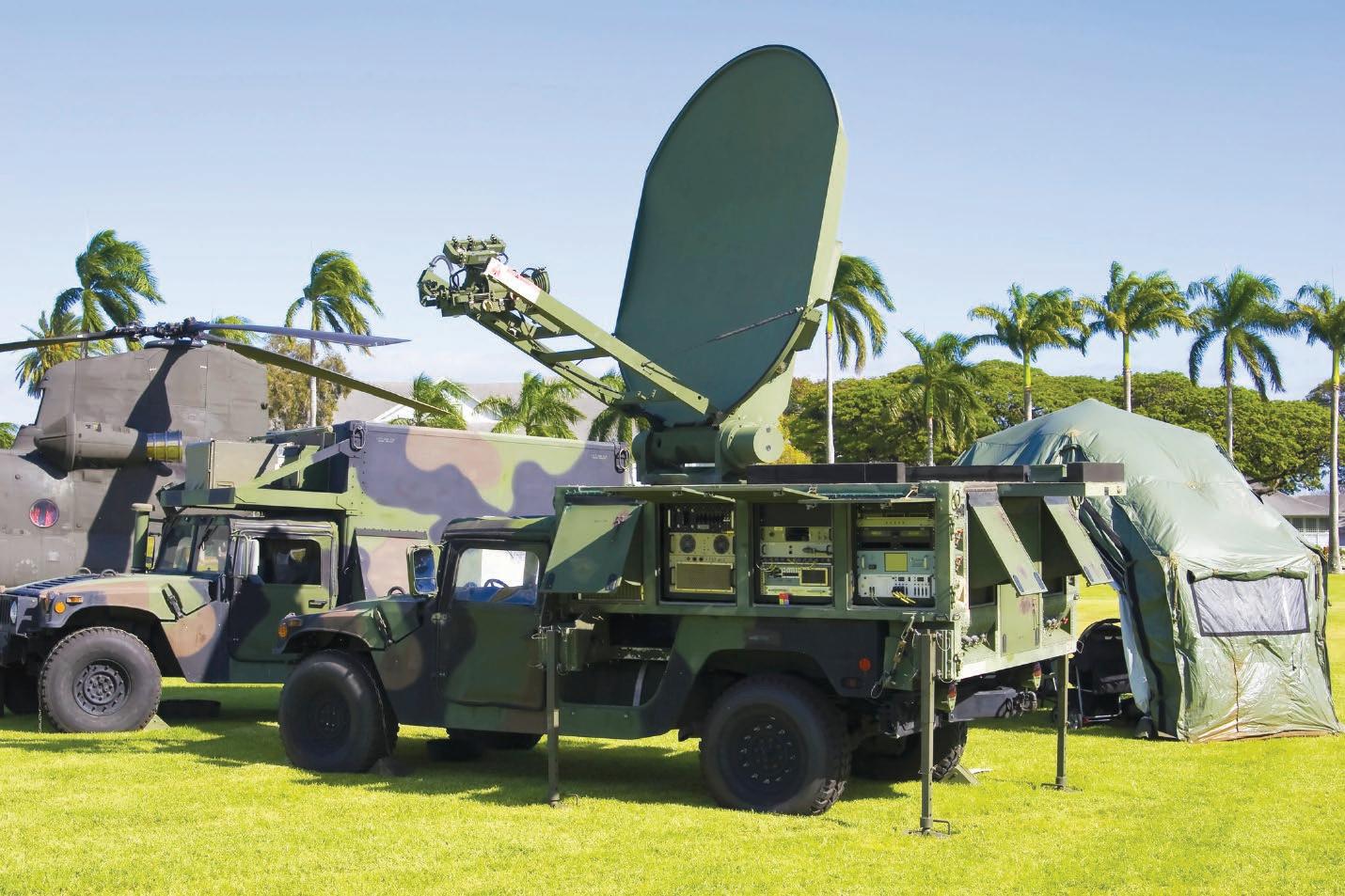
Technology differentiation is key to force effectiveness. To this end, defence spending on improving system capabilities in C4I and ECM applications is expected to grow at a CAGR of around 10% in 2025.
Future Trends –HUBER+SUHNER Technologies and Capabilities
HUBER+SUHNER is already seeing a number of changes in the technology and capabilities landscape that will impact defence products and services in the near future. Chief among these changes are the introduction of new materials into battlefield and infrastructure technologies and the need for a truly globalised supply chain.
Summary of Global Defence Spending Outlook – 2025
New materials: Whilst the defence industry is well known for its use of new materials, advances in the composites industry are creating significant new opportunities that support mobility through the light-weighting of systems. HUBER+SUHNER’s high-end polymers technology is already generating a significant amount of interest within defence communication platforms.
Globalised supply chains: Localisation of products and services is growing in significance. This “indigenisation” of supply chains and know-how provides a means of independence while, at the same time, creating new commercial markets. With 13 production facilities located in 12 countries spread across the globe, HUBER+SUHNER is perfectly positioned to provide supply chain expertise and support on a global scale.
IMPROVING SECURITY OF COMMUNICATION LINKS IN CRITICAL MILITARY MISSIONS WITH RF-OVER-FIBER TECHNOLOGY 12 | WWW.GLOBALBUSINESSMEDIA.ORG
In the Asia-Pacific, it is expected that border and maritime disputes, linked to geopolitical activities, will continue to drive increases in defence spending
Sector CAGR Total (from) Defence industry growth (overall): 4% US $ 2.5 trillion (US $ 1.7t) Maintenance, Repairs & Overhauling (overall): 7% US $ 130 billion (US $ 66b) C4I & ECM Applications 10% US $ 21.5 billion (US $ 8.4b)
RF-over-Fiber in Action
Don McBarnet, Defence Technology Writer
“As we look at future threats, enhanced electronic warfare is more essential than ever to improve overall survivability. We look forward to adding this next generation capability to enhance the air superiority mission of the F-15.”
THE ADVANTAGES of using RF-over-Fiber extend from the latest and fastest upgrades to the F-15 by Boeing8 to missiles for the BAE Systems towed array decoy. BAE Systems AN/ ALE-55 Fiber Optic Towed Decoy, (AN/ALE55 subsystem) consists of an on- board signal conditioning assembly and an FOTD (Fiber Optic Towed Decoy). The signal conditioning assembly converts RF frequencies to light for transfer through the fiber optic line. In the primary mode, the on-board EW (Electronic Warfare) system detects and analyses a threat, determines the appropriate response, and then sends that response down the line to the FOTD for transmission. This decoy offers protection to fighter aircraft, bombers and transport aircraft and can be adapted or upgraded to changing threats.9
RF-over-Fiber Valued in Naval and Land Applications
The vast scope and diversity of specifically military applications of RF-over-Fiber is very extensive indeed. Looking at a prime contractor such as Thales offerings of vehicles and their integrated communication systems, it is clear that installing RF-over-Fiber systems within vehicles10, ships and submarines has now become a standard to which legacy vehicles11 and platforms are being upgraded.
RF-over-Fiber Offers Commercial Aircraft Enhanced Safety
A longstanding safety and security issue for commercial aircraft has been foreign object debris on airport runways. This can be anything from a dropped tool for maintenance of an aircraft to a bird flying over the runway. The crash by the Concorde jet, Air France Flight 4590, in 2000 is perhaps the most horrific example. The Concorde crashed in flames shortly after taking off from
Charles de Gaulle Airport in France. According to The New York Time’ Report in 201212, the engineer for the Continental Airlines aircraft that preceded the Concorde on the runway had attached a piece of metal, a “wear strip”, to the United Continental DC-10, which fell off during take off and punctured the tyre of the following Concorde on take off. This train of events lead to the Concorde’s crash. Using The New York Times words: “Olivier Metzner, the lawyer representing United Continental, said (to The New York Times) by telephone (in 2012) that he was satisfied that the ruling (by the French appellate court) would put an end to efforts to make the American carrier a scapegoat for an accident that he argued was the result of failures by French air safety regulators.” The understanding from the outcome of the prolonged legal action was that the responsibility to keep airport runways safe lies with the airport and the national safety regulators. Therefore, there has been a new and urgent commercial case for upgrading the security of runways by frequent checks, visual and sensor checks to ensure they are clear for every flight. This has lead to the rapid development and implementation of RF-overFiber airport runway surveillance systems.
QinetiQ’s Tarsier System and Other FOD Prevention Systems
The 2000 crash at Charles de Gaulle brought Foreign Object Debris (FOD) prevention to the top of the safety agenda for airports. The need for heightened awareness and training for improved security on this issue was raised still further by the US Federal Aviation Authority, who issued an Advisory Circular13. Airports are taking action and many have adopted an automatic debris detection system to double up on the required visual inspection of the runway. QinetiQ’s Tarsier system was installed at Heathrow, which added to the frequent visual inspections that had been the British Airport Authority’s Heathrow norm.
IMPROVING SECURITY OF COMMUNICATION LINKS IN CRITICAL MILITARY MISSIONS WITH RF-OVER-FIBER TECHNOLOGY WWW.GLOBALBUSINESSMEDIA.ORG | 13
Lt. Col. James Parslow, the Air Force’s F-15 EPAWSS (Eagle Passive Active Warning Survivability System) program manager
A longstanding safety and security issue for commercial aircraft has been foreign object debris on airport runways
The radar element of the system constantly scans the runway and sounds an alarm in ASD (Airside Safety Department) on detection of potential debris.14 The high zoom camera then pans to display an image of the object, allowing the operator to confirm the item and assess the risk it poses. Detected items can sometimes be decidedly low risk – leaves and grass cuttings. This system is in line with the recent FAA Advisory Circular to airport managers to use prevention systems to detect and prevent FOD being on the runway and causing damage.15 The strength of the warning contained in the United States Department of Transport Advisory Circular makes a strong case for many airports, especially those in the United States, to use foreign object detection systems. There are others such as Singapore based Stratech’s iFerret.16 The installation of these FOD prevention systems is a highly competitive market. However, upgrades in runway security of the world’s airports are of benefit to all commercial aircraft users. And undoubtedly the systems that improve commercial aircraft security will also improve security on military runways.
The 2000 crash at Charles de Gaulle brought Foreign Object Debris (FOD) prevention to the top of the safety agenda for airports

IMPROVING SECURITY OF COMMUNICATION LINKS IN CRITICAL MILITARY MISSIONS WITH RF-OVER-FIBER TECHNOLOGY 14 | WWW.GLOBALBUSINESSMEDIA.ORG
It is clear that installing RF-over-Fiber optic systems within vehicles, ships and submarines has now become a standard to which legacy vehicles and platforms are being upgraded
Harnessing the Micro Electronics Revolution
Mary Dub, Editor
PREDICTING
THE future is always a high risk endeavour, never more so than in an industry, which is at the forefront of disruptive change from materials science, new coatings advances and nanotechnology. Governments, departments of defence and customers are always asking for products to be smaller, faster, lighter and, of course, cheaper. Not surprisingly the work of research scientists, technologists and industry, is to deliver this, even if it is frequently seen as a significant challenge. What are the constraints on future development? First is budget. Western European countries and, to a certain extent the United States, are caught within a slow GDP growth curve. This is less true of the Asia Pacific regions, the Indian subcontinent and the Middle East and Africa. Here, high rates of growth in the consumer market are leading to exponential levels of demand for mobile streamed data. Just looking at the shortest term, a future time frame of the next 12 months, the CISCO White Paper forecast figures are worth noting again. More than half a billion (563 million) mobile devices and connections were added in 2015. Smartphones accounted for most of that growth. Global mobile devices and connections in 2015 grew to 7.9 billion, up from 7.3 billion in 2014.17
The Exponential Growth in Network Mobile Data Demand
Following the growth in use of mobile devices is the exponential growth in mobile data demand. By 2015, more than half of all traffic from mobileconnected devices (almost 3.9 exabytes) will be offloaded to the fixed network by means of WiFi devices and femtocells each month. Without Wi-Fi and femtocell offload, total mobile data traffic would grow at a CAGR of 55% between 2015 and 2020, instead of the projected CAGR of 53%. The Middle East and Africa will have the strongest mobile data traffic growth of any region with a 71% CAGR. The Asia Pacific follows this region at 54% and Central and Eastern Europe at
52%. The potential demand for RF-over-Fiber and LAN-over-Fiber is high. The potential military demand by countries with the budget and ambition to upgrade their legacy platforms and equipment is also high despite low or diminishing defence budget growth in Western Europe and the United States.
DARPA’s Vision of the Achievable Future in Recent Budget Requests to the President
In February 2016, DARPA’s Budget request to the President for 2017 presents a vision of the military’s medium term future military technical capabilities. In the budget request, optoelectronic devices, circuits and processing concepts are at the heart of the US Army mission. These processes will provide new technical options for meeting the information gathering, transmission and processing requirements to maintain near real time knowledge of the enemy and the ability to communicate decisions based on that knowledge to all forces in near real time18. As this is a budget request, the format of intentions reads like a list, but what a list! Research areas include new electronic and optoelectronic devices and circuit concepts, the operation of devices at higher frequencies and lower power, the extension of laser diodes to new wavelength ranges relevant to military missions, the development of innovative optical and electronic technologies for interconnecting modules in high performance systems, research into field portable electronics with reduced power requirements, and system and component level improvements to provide greater affordability and reliability.19 Yes, if the budget goes through and plans succeed, these new devices really will be smaller, lighter, faster and, crucially, use less power.
DARPA’s Hollow Air filled Core: Light through Air
Aviation Week and Space Technology reported that DARPA has achieved what they describe
IMPROVING SECURITY OF COMMUNICATION LINKS IN CRITICAL MILITARY MISSIONS WITH RF-OVER-FIBER TECHNOLOGY WWW.GLOBALBUSINESSMEDIA.ORG | 15
It is clear that the potential for RF fiber optic cable to deliver mobile broadband, which is being demanded by the millions of new users of smart phones across the globe, is there
as a milestone in fiber optic design with the development of a hollow air-filled core that forces light to move through channels of air instead of glass. As a result, light properties increase significantly. The hollow-core fiber is reportedly the first to maintain properties in three key areas. These include single-spatial mode, meaning light takes a single path, permitting higher bandwidths over longer distances.20 These are capabilities of laser beams over cable that may transform the industry in a few years or may lead to a mere footnote in a technology
history book. It is impossible to predict. Leaving aside the outlying ideas of government-financed research technologists at DARPA, it is clear that the potential for RF-over-fiber to deliver mobile broadband, which is being demanded by the millions of new users of smart phones across the globe, is there. The capability to deliver RF-overFiber products that are light, rugged, low loss, low noise and that enhance the safety, security and performance objectives of a wide range of military applications means that competition in this market will be intense.

IMPROVING SECURITY OF COMMUNICATION LINKS IN CRITICAL MILITARY MISSIONS WITH RF-OVER-FIBER TECHNOLOGY 16 | WWW.GLOBALBUSINESSMEDIA.ORG
Governments, departments of defence and customers are always asking for products to be smaller, faster, lighter and, of course, cheaper
References:
1 A RAND note on Military Applications of Fiber Optics Technology by Joseph Benzoni, and David Orietsky May 1989 https://www.rand.org/content/dam/rand/pubs/notes/2007/N2866.pdf
2 A RAND note on Military Applications of Fiber Optics Technology by Joseph Benzoni, and David Orietsky May 1989 https://www.rand.org/content/dam/rand/pubs/notes/2007/N2866.pdf
3 JOURNAL OF LIGHTWAVE TECHNOLOGY Feasibility Demonstration of a Mode-Division
Multiplexed MIMO-enabled Radio-over-Fiber Distributed Antenna System
George S.D. Gordon, Student Member, IEEE, Michael J. Crisp, Member, IEEE, Richard V. Penty, Senior Member, IEEE, Timothy D. Wilkinson, Senior Member, IEEE, and Ian H. White, Fellow, IEEE http://tiny.cc/1qzs9x
4 Cisco com Executive Summary The Mobile Network in 2015
http://www.cisco.com/c/en/us/solutions/collateral/service-provider/visual-networking-index-vni/mobile-white-paper-c11-520862.html
5 JOURNAL OF LIGHTWAVE TECHNOLOGY Feasibility Demonstration of a Mode-Division
Multiplexed MIMO-enabled Radio-over-Fiber Distributed Antenna System, George S.D. Gordon, Student Member, IEEE, Michael J. Crisp, Member, IEEE, Richard V. Penty, Senior Member, IEEE, Timothy D. Wilkinson, Senior Member, IEEE, and Ian H. White, Fellow, IEEE http://tiny.cc/przs9x
6 Exhibit R-2A, RDT&E Project Justification: PB 2017 Defense Advanced Research Projects Agency Date: February 2016 Appropriation/Budget Activity 0400 / 1 R-1 Program Element (Number/ http://www.darpa.mil/attachments/DARPAFY17PresidentsBudgetRequest.pdf
7 Exhibit R-2A, RDT&E Project Justification: PB 2017 Defense Advanced Research Projects Agency Date: February 2016 Appropriation/Budget Activity 0400 / 1 R-1 Program Element (Number/ http://www.darpa.mil/attachments/DARPAFY17PresidentsBudgetRequest.pdf
8 BAE Systems EW Electronic Warfare communication between planes to enable immediate communication
http://www.baesystems.com/en/product/electronic-warfare
9 AN/ALE-55 Fiber-Optic Towed Decoy: www.baesystems.com/en/product/anale55-fiberoptic-towed-decoy
10 Thales Land Communication Intelligence and Electronic Warfare
https://www.thalesgroup.com/sites/default/files/asset/document/2014_rcp_catalogue_-_all_pages_1.pdf
11 VEHICLE COMMUNICATION NODES
https://www.thalesgroup.com/sites/default/files/asset/document/2014_rcp_catalogue_-_all_pages_1.pdf
12 French Court Overturns Convictions in Concorde Crash By NICOLA CLARKNOV. 29, 2012
http://www.nytimes.com/2012/11/30/business/global/french-court-overturns-conviction-in-concorde-crash.html?_r=0
13 US Department of Transportation , Federal Aviation Administration Advisory Circular 9/30/2010 Airport Foreign Object Debris (FOD) Management
14 Tarsier QinetiQ, Heathrow http://www.tarsier.qinetiq.com/imagery/Documents/tarsier_heathrow_case_study.pdf
15 US Department of Transportation , Federal Aviation Administration Advisory Circular 9/30/2010 Airport Foreign Object Debris (FOD) Management
http://www.faa.gov/documentLibrary/media/Advisory_Circular/150_5210_24.pdf
16 iFerret http://www.thestratechgroup.com/iv_iferret.asp
17 Cisco Global Mobile Data Traffic Forecast Update 2015-2020
http://www.cisco.com/c/en/us/solutions/collateral/service-provider/visual-networking-index-vni/mobile-white-paper-c11-520862.html
18 Exhibit R-2A, RDT&E Project Justification: PB 2017 Defense Advanced Research Projects Agency Date: February 2016
Appropriation/Budget Activity 0400 / 1 R-1 Program Element
(Number/ http://www.darpa.mil/attachments/DARPAFY17PresidentsBudgetRequest.pdf A. Mission Description and Budget Item Justification
19 Exhibit R-2A, RDT&E Project Justification: PB 2017 Defense Advanced Research Projects Agency Date: February 2016
Appropriation/Budget Activity 0400 / 1 R-1 Program Element
(Number/ http://www.darpa.mil/attachments/DARPAFY17PresidentsBudgetRequest.pdf A. Mission Description and Budget Item Justification
20 Aviation Week & Space Technology – Defense Technology Edition Hollow Fiber-Optic Boosts Light Performance
Aug 5, 2013 Aviation Week & Space Technology - Defense Technology Edition http://aviationweek.com/awin/hollow-fiber-optic-boosts-light-performance
IMPROVING SECURITY OF COMMUNICATION LINKS IN CRITICAL MILITARY MISSIONS WITH RF-OVER-FIBER TECHNOLOGY WWW.GLOBALBUSINESSMEDIA.ORG | 17






















